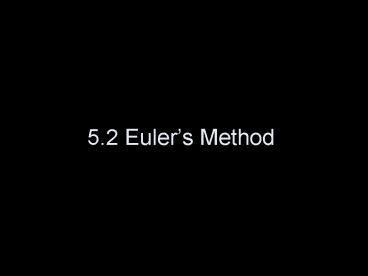5'2 Eulers Method - PowerPoint PPT Presentation
1 / 10
Title:
5'2 Eulers Method
Description:
5.2 Euler's Method. Leonhard Euler (1707-1783) Euler. Levy. Pollack. Waltz. Winston. Minsky. Tucker. Lefschetz. Story. Klein. Lipschitz. Y'all. Dirichlet. Fourier ... – PowerPoint PPT presentation
Number of Views:81
Avg rating:3.0/5.0
Title: 5'2 Eulers Method
1
5.2 Eulers Method
2
Leonhard Euler (1707-1783)
Euler
Lagrange
Fourier
Dirichlet
Lipschitz
Klein
Story
Lefschetz
Tucker
Minsky
Winston
Waltz
Pollack
Levy
Yall
3
Motivation
- Accumulating a value (stock variable) requires us
to integrate it - Sometimes definite integral exists (analytical
solution) f(x) x2 ? ?f(x) dx x3 / 3 - Sometimes it does not f(x) e-x2
- In such cases we use numerical methods to
approximate the integral (Euler, Runge-Kutta 2
and 4)
4
Example
- We use a somewhat artificial example where there
is an analytical solution, to compare numerical
methods with it. - Consider dP/dt 0.10P with P0100. We know that
P 100e0.10t - General finite difference equation is
- P(t) P(t-?t) growth(t)?t
- Lets compute P(8) for this example
5
Example
- dP/dt 0.10P with P0100
- P(t) P(t-?t) growth(t)?t with ?t 8
- P(t-?t) growth_rateP(t-?t)?t with ?t 8
- P(t-8) 0.10 P(t-8) 8
- P(t-8) 0.80 P(t-8)
- P(t-8) (1 0.80)
- 1.8P(t-8)
- Lets compute P(8).
6
Example
- P(t) 1.8P(t-8)
- P(8) 1.8P(0)
- 1.8100
- 180
- Check against analytical solution
- P 100e0.10t
- P8 100e(0.10)(8) 223
7
Example
8
Algorithm for Eulers Method
t ? t0 P(t0)? P0 Initialize SimulationLength while
t lt SimulationLength do the following t ? t
?t P(t) ? P(t - ?t) P(t - ?t) ?t
Whats wrong with this picture?
9
Better Algorithm for Eulers Method
t ? t0 P(t0)? P0 Initialize NumberOfSteps for n
going from 1 to NumberOfSteps do the
following tn ? t0 n?t Pn ? Pn-1 f(tn-1,
Pn-1 )?t
where f is the derivative at a given time step
10
Error Vanishes in the Limit
- For ?t 8, relative error 180-223/223
19 - For ?t 1
- P(t) P(t-1) 0.10 P(t-1) 1
- P(t-1) 1.1
- 100 1.1
- 110
- P 100e0.10t
- P8 100e(0.10)(1)
- 100e(0.10)(1)
- 111
- Relative error 110-111/111 1































